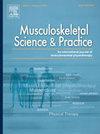原始和简短的Örebro肌肉骨骼疼痛问卷对腰痛的最小临床重要差异
IF 2.2
3区 医学
Q1 REHABILITATION
引用次数: 0
摘要
背景Örebro肌肉骨骼疼痛问卷(Örebro),虽然最初是作为筛选工具设计的,但在文献中已被广泛用作结果测量。据我们所知,还没有研究将Örebro的表现作为结果衡量标准。最小临床重要差异(MCID)是结果测量的基本心理测量特性。本研究旨在评估Örebro(原始版本和简短版本)作为结果测量的性能,包括建立其MCID。方法本研究为随机对照试验的二次分析。研究样本包括300名接受物理治疗的腰痛患者。患者在5个时间点完成Örebro。为了建立MCID,我们采用基于锚定的受试者工作特征(ROC)曲线分析方法作为主要分析方法,并辅以基于分布的测量标准误差方法。根据分配的治疗组和Örebro基线评分进行亚群分析。结果两份问卷均能检测到随时间的变化,曲线下面积(auc)均为0.7。锚定法对Örebro和SF-Örebro的MCID分别为20.3和9.0。使用基于分布的方法,Örebro的MCID为23.6,SF-Örebro的MCID为12.1。基线评分较高的个体的MCID更大,但似乎与治疗组无关。结论两份问卷均适用于检测随时间的变化。据我们所知,这是第一个报告两份问卷的MCID估计的研究。本文章由计算机程序翻译,如有差异,请以英文原文为准。
Minimum clinically important difference of the original and short-form Örebro musculoskeletal pain questionnaire for low back pain
Background
The Örebro Musculoskeletal Pain Questionnaire (Örebro), although originally designed as a screening tool, has become more prevalently used as an outcome measure in the literature. To our knowledge, no study has investigated the Örebro's performance as an outcome measure. The minimum clinically important difference (MCID) is a fundamental psychometric property of outcome measures.
Objectives
This study aimed to evaluate the performance of the Örebro (original and short-form versions) as an outcome measure, including establishing its MCID.
Methods
This was a secondary analysis of a randomised controlled trial. The study sample consisted of 300 low back pain patients, receiving physiotherapy. Patients completed the Örebro at 5 timepoints. To establish the MCID, an anchor-based method using receiver operating characteristic (ROC) curve analysis was utilised as our primary analysis method, supplemented with a distribution-based method deriving the standard error of measurement. Subpopulation analyses were carried out based on allocated treatment group and Örebro baseline score.
Results
Both questionnaires were capable of detecting change over time as all area under the curves (AUCs) were >0.7. The MCID was 20.3 for the Örebro and 9.0 for the SF-Örebro according to anchor-based methods. Using distribution-based methods, the MCID for the Örebro was 23.6 and 12.1 for the SF-Örebro. The MCID was larger for individuals with a higher baseline score but appeared independent of treatment group.
Conclusions
Both questionnaires were suitable for detecting change over time. To our knowledge, this is the first study to report a MCID estimation for either questionnaire.
求助全文
通过发布文献求助,成功后即可免费获取论文全文。
去求助
来源期刊

Musculoskeletal Science and Practice
Health Professions-Physical Therapy, Sports Therapy and Rehabilitation
CiteScore
4.10
自引率
8.70%
发文量
152
审稿时长
48 days
期刊介绍:
Musculoskeletal Science & Practice, international journal of musculoskeletal physiotherapy, is a peer-reviewed international journal (previously Manual Therapy), publishing high quality original research, review and Masterclass articles that contribute to improving the clinical understanding of appropriate care processes for musculoskeletal disorders. The journal publishes articles that influence or add to the body of evidence on diagnostic and therapeutic processes, patient centered care, guidelines for musculoskeletal therapeutics and theoretical models that support developments in assessment, diagnosis, clinical reasoning and interventions.
 求助内容:
求助内容: 应助结果提醒方式:
应助结果提醒方式:


